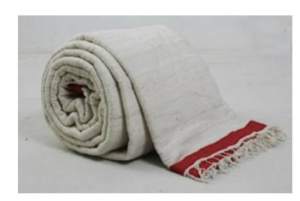Language/Amharic/Culture/Cultural-clothing
The people of Ethiopia wear many different types of traditional clothes. The traditional costume of the Christian highland peasantry includes a wrap or scarf made of woven cotton. Ethiopian men and women wear this traditional costume called ጋቢ gabi (thick white cotton wrap worn when it is cold) or ነጠላ nät’älla (thinner white wrap with embroidered borders). Women often wear traditional dresses called ቀሚስ k’ämis and ነጠላ nät’älla mostly in rural areas.
Other ethnic groups and tribes in the south and west of the country wear different costumes that reflect their own traditions. Some tribes partially cover their body with leather but others do not wear any clothes at all, merely decorating their faces and bodies with distinctive images. In many of the northeastern Muslim areas, traditional Arab dress is still worn, including the hijab, headscarf, and burka.
The Muslim of Harar wear very colorful dress, the men in shorts and a colorful wrap and the women in fine dresses of red, purple and black. The lowland Somali and Afar people wear long, brightly colored cotton wraps, and the Oromo and Bale people are often to be seen in the decorated leather garment that reflect their economy, which is based on livestock. Costume to some extent reflects the climate where the different groups live- highlanders, for instance, use heavy cloth capes and a wraparound blanket to combat the night chill. In the heat of the lowland plains, light cotton clothes are all that is required by men and women alike.
Traditional dress, though often now supplanted by Western attire, may still be seen throughout much of the countryside. National dress is usually worn for festivals, when streets and meeting places are transformed into a sea of white as finely woven cotton dresses, wraps decorated with colored woven borders, and suits are donned. A distinctive style of dress is found among the Oromo horsemen of the central highlands, who, on ceremonial days such as መስቀል mäsk’äl, attire themselves in lions’ mane or baboon-skin headdresses and, carrying hippo-hide shields and spears, ride down to the main city square to participate in the parades.
Ethiopians are justifiably proud of the range of their traditional costumes. The most obvious identification of the different groups is in the jewelry, the hairstyles and the embroidery of the dresses. The women of Amhara and Tigray wear dozens of plaits (ሹሩባ šuruba) tightly braided to the head and billowing out at the shoulders. The women of Harar part their hair in the middle and make a bun behind each ear. Hamer, Geleb, Bume and Karo men form a ridge of plaited hair and clay to hold their feathered headwear in place. Arsi women have fringes and short, bobbed hair. Bale girls have the same, but cover it with a black head cloth, while young children often have their head shaved.
Jewelry in silver and gold is worn by Muslim women and by Christians, with amber or glass beads incorporated. Heavy brass, copper and ivory bracelets and anklets are also worn.
After mastering this lesson, these related pages might interest you: Ethiopian Cuisine, Ethiopian Holidays and Festivals, Invitations in Ethiopia & Threatening Safety Tips for Female Volunteers.
Source[edit | edit source]
https://www.livelingua.com/peace-corps/Amharic/Amharic%20Peace%20Corps%20Language%20Manual-2015.pdf
Other Lessons[edit | edit source]
- Patterns of Meeting People
- Guide to Ongoing Language Learning
- Threatening, Harassing, or Disrespectful Body Language
- Inquiring About Marital Status
- Invitations in Ethiopia
- Dämbäña System in Ethiopia
- Time
- Banknotes and coins
- Dating and Romantic Relationships
- Sexual Harassment in Ethiopia


